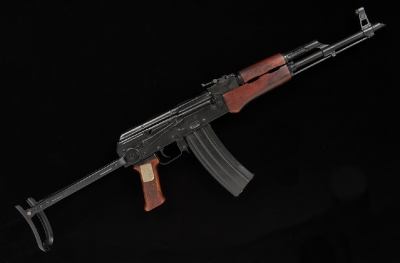AK-63E (AK-47) (1990.60.1)
This is a Hungarian AKM, the successor to the iconic AK-47 gas-operated assault rifle. Named after its young Russian inventor, Mikhail Kalashnikov, who perfected the design in 1947, the AK-47 was simple, robust, and reliable. It also offered flexibility in the field with both semi- or fully-automatic modes.
Towards the end of the Second World War it became clear that warfare was changing. Soldiers rarely engaged targets beyond 400 metres and set-piece battles gave way to strategic skirmishes, assaults and ambushes in which short bursts of automatic fire were desirable. Germany was the first to recognise this shift, deploying the first mass-produced assault rifle, the revolutionary Sturmgewehr 44, in 1944. The major world powers soon began to follow suit, developing intermediate-power cartridges and lightweight selective-fire rifles. The most successful was the 7.62x39mm cartridge chambered in the AK-47.
The AKM, introduced in 1961, was a modified version of the AK-47. Designed for mass-production it was lighter than it's parent weapon, with stabilizing ribs on the receiver, and a slightly slower rate of automatic fire to improve accuracy. The AKM became the most widespread of all Kalashnikov-type rifles; around 70 million have been made. This AKM with a folding stock (AKMS) was introduced in Hungary in the 1970s with the designation AK-63E. Manufactured by the Fegyver- és Gépgyár (FÉG) state arms plant, it is still used by the Hungarian military today. It was also exported for use in South America in the 1980s and also played a part in the Yugoslav and Gulf Wars of the 1990s.
Interviewed in 2002, then aged 82, Mikhail Kalashnikov said he was proud of his invention but sad that it had been used by terrorists. He said he would have preferred to have used his technical knowledge to design something more useful that would help farmers with their work, such as a lawnmower.





